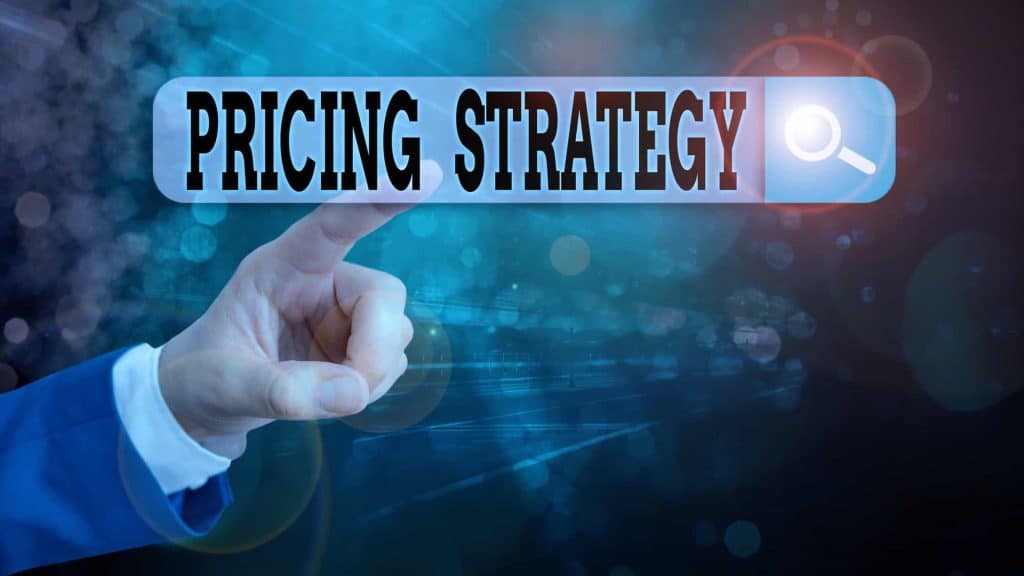
Welcome to the gateway of strategic pricing—a critical yet often overlooked cornerstone of business success. Whether you’re just dipping your toes into the entrepreneurial world or looking to refine your business acumen, understanding the nuances of pricing strategies is your first step towards mastering the art of profitability. Let’s dive in, shall we?
Why is pricing so pivotal, you ask? Well, think of it as the heartbeat of your business strategy. Get it right, and you pave the way for healthy profit margins, robust sales, and a competitive edge sharp enough to cut through market noise. But if you get it wrong? It’s like setting sail without a compass—you might stay afloat, but you’ll be adrift in a sea of uncertainty.
Pricing isn’t just about covering costs and adding a markup; it’s a complex interplay of value perception, market demand, and psychological factors. For instance, a study by Bain & Company highlighted that a mere 1% improvement in pricing can boost profits by up to 8.7%. That’s the power of strategic pricing!
Moving from basic to advanced pricing techniques is like transitioning from playing checkers to playing chess. It requires foresight, strategy, and an understanding of the myriad factors that influence pricing dynamics.
Transitioning to advanced pricing techniques means embracing a learning curve. But fear not! With a dash of curiosity and a pinch of perseverance, you’ll find that mastering these strategies is not only possible but also incredibly rewarding.
Let’s break down the essentials:
Incorporating real-world examples, like how Apple masters value-based pricing by emphasizing the unique features and design of its products, can offer practical insights into these concepts in action.

Diving into strategic pricing might seem daunting at first, but remember, every expert was once a beginner. By embracing a mix of analysis, creativity, and strategic thinking, you’ll not only uncover the optimal pricing strategy for your business but also unlock the door to sustainable growth and success.
Embarking on the journey of setting the right price for your product can sometimes feel like you’re a contestant on “The Price Is Right.” Guess too high, and you might scare away your potential customers. Guess too low, and well, you’re undervaluing what you’ve worked so hard to create. Let’s navigate through the essentials of product pricing strategies together, shall we?
Imagine you’re at a farmers’ market. On one stall, you see a sign: “Organic, hand-picked apples: $5/kg.” Right next to it, another sign says: “Apples, $3/kg.” Which one do you choose? If you’re leaning towards the organic apples, you’ve just experienced value-based pricing in action.
Cost-based pricing is like the foundation of a house. You calculate the cost of producing your product, slap on a margin that makes you smile, and voila, you have your price. It’s straightforward but doesn’t always capture the full picture. Here’s where value-based pricing enters the scene, like a hero in a cape. This approach involves setting prices based on the perceived value of your product to the customer. It’s like saying, “Hey, these aren’t just any apples. They’re worth more because they’re organic and hand-picked with love.”
Here’s a nugget of wisdom: a study by Deloitte found that businesses utilizing value-based pricing strategies can increase their margins by as much as 40%. That’s not just a small boost; it’s a game-changer!
So, how do you find that sweet spot between cost and value? Here are a few pointers:
Now, let’s talk about the dance of competitive pricing. It’s like being at a party where you’re constantly checking out what others are wearing to make sure you fit in yet stand out. In the world of business, this means keeping an eye on your competitors’ pricing while ensuring your product stands out for the right reasons.
Competitive pricing doesn’t mean you have to be the cheapest on the block. It’s about positioning your price in a way that makes sense in the context of the market. It’s like saying, “Our apples might be the same price as theirs, but ours are juicier and come with a smile.”
But beware, engaging in a price war can lead to a race to the bottom where nobody wins. Instead, focus on what makes your product unique. Is it better quality? More sustainable? Easier to use?
Here’s a pro tip: use pricing intelligence tools to keep an eye on your competitors. This way, you can make informed decisions without constantly looking over your shoulder.
To wrap this section up with a bow, remember:
The performing arts world is a treasure trove of inspiration, not least when it comes to innovative pricing strategies. From theaters to concert halls, creative minds have been crafting pricing models that not only fill seats but also deepen audience engagement. Let’s pull back the curtain on how these artistic venues are hitting the high notes with their pricing strategies.
In the spotlight of the performing arts sector, dynamic and tiered pricing models take center stage. These aren’t just buzzwords; they’re the backbone of a strategy designed to maximize both attendance and revenue. Consider the Metropolitan Opera in New York, which employs a dynamic pricing model. The prices for tickets fluctuate based on demand, time of booking, and even the popularity of the show. This approach ensures that the house is packed, and the excitement is palpable, all while optimizing revenue.
But the innovation doesn’t stop there:
Diving deeper into the realm of creativity, the performing arts sector has also embraced models that break the traditional boundaries of pricing. The key? Offering more than just a ticket; it’s about creating an experience.
A fascinating case study comes from the National Theatre in London, which introduced a scheme allowing under-26-year-olds to access tickets for just £5. This initiative, supported by external funding, not only filled seats but also cultivated a younger audience, ensuring the future vibrancy of the theater scene.
So, what can businesses outside the performing arts learn from these creative pricing strategies? Here are a few takeaways:
As we draw the curtains on this section, remember, the performing arts sector teaches us that pricing strategies can indeed be as dynamic and creative as the performances themselves. Whether you’re selling products, services, or experiences, there’s much to learn from the art world’s approach to pricing. So, why not take a leaf out of their playbook and orchestrate your pricing strategy to not just meet the market but to perform a standing ovation-worthy show?
Diving into the world of pricing, it’s not all about numbers and profits; it’s also a game of psychology. Ever wondered why prices often end in .99 or .95 instead of rounding up? That’s psychological pricing at work, subtly influencing how we perceive and process price information. This section uncovers the clever tactics businesses use to make their prices more appealing and, yes, sometimes a little less straightforward.
“Price endings,” those last digits of a price, play a crucial role in how customers perceive value. The classic example is the .99 ending, often referred to as “charm pricing.” It’s not just a random choice; there’s solid psychology behind it. A study published in the Journal of Retailing suggests that prices ending in .99 can significantly increase sales compared to rounding them up to the nearest dollar. This effect, known as the “left-digit effect,” occurs because consumers tend to focus on the first digit of a price, perceiving a $2.99 item as being closer to $2 than $3.
But why stop at .99? Retailers have experimented with various price endings, such as:
Implementing price endings effectively requires understanding your audience and product positioning. A luxury brand might steer clear of .99 endings to maintain an aura of exclusivity, while a discount retailer might embrace it to highlight value.
Contextual pricing takes into account the broader situation in which a product is presented, influencing how its price is perceived. It’s not just about the price itself but about how it compares to others in its vicinity. For example, placing a premium product next to a more expensive option can make it seem more affordable—a tactic known as the “decoy effect.”
Effective contextual pricing strategies include:
A fascinating case study in contextual pricing is Apple’s product lineup. By presenting products with a range of specifications and prices, Apple not only caters to different customer segments but also creates a perception of value and choice that encourages upselling.

Venturing into the international market is like embarking on a grand world tour. It’s thrilling, packed with opportunities, and yes, a bit daunting, especially when it comes to pricing. How do you set prices that resonate across diverse economic landscapes and cultural tapestries? Let’s navigate these global waters together.
Currency rates love to dance, fluctuating more often than the latest TikTok trend. These changes can dramatically affect how your products are priced and perceived abroad. An approach that works wonders is Price Localization, which isn’t just about converting your prices into local currency but also about adjusting them to match the local purchasing power. For example, Big Mac Index, an informal way of measuring the purchasing power parity (PPP) between two currencies, provides insights into how pricing can vary significantly even for identical products.
Here’s what you need to consider:
Culture shapes our values, and yes, it even influences how we perceive prices. What’s considered a bargain in one country might be seen as overpriced in another. Diving into cultural preferences can reveal insights into how to structure your pricing strategies effectively.
Let’s consider a few cultural nuances:
To effectively adapt your pricing to cultural impacts, consider the following:
Navigating the world of pricing strategies can feel like being a chef in a gourmet kitchen. You have all these ingredients – costs, competition, customer value – but how do you mix them to create a recipe for success? Let’s walk through a step-by-step guide to developing a pricing strategy that not only covers your costs but also delights your customers and outsmarts your competition.
1. Understand Your Costs: It all starts here. You need to know the minimum price to cover your production, operation, and distribution costs. Ignoring this step is like trying to bake a cake without knowing if you have enough flour.
2. Analyze Your Market: Who are you competing with? What are they charging? More importantly, what are customers willing to pay? Market research is your friend, providing insights into pricing benchmarks and customer expectations.
3. Define Your Value Proposition: What makes your product or service special? Are you offering luxury quality, unbeatable prices, or perhaps an innovative solution to a common problem? Your prices should reflect the value you bring to the table.
4. Choose Your Pricing Strategy: From cost-plus to value-based pricing, there’s a myriad of strategies out there. Pick one that aligns with your market research, value proposition, and business goals.
5. Test and Adjust: Launching your pricing is just the beginning. Market conditions change, and so should your prices. Be ready to adjust based on sales data, customer feedback, and changes in your costs or the competitive landscape.
Remember, the key is flexibility. Like any good chef, don’t be afraid to tweak your recipe based on the ingredients at hand and the preferences of your diners.
Developing a pricing strategy isn’t a solo mission. It requires the collective insights and expertise of your entire team, from sales to marketing, from finance to customer support. Each department can provide valuable perspectives on how pricing affects different aspects of the business and the customer experience.
Incorporating customer feedback and internal insights can transform a good pricing strategy into a great one. For instance, if customers indicate that your product is great but slightly out of their price range, consider introducing payment plans or a lower-cost version to capture a wider audience.

In the ever-evolving marketplace, treating your pricing strategy as a “set and forget” tool is akin to navigating a ship with a compass that doesn’t adjust for the changing currents. The key to maintaining competitiveness and maximizing profits lies in continuous monitoring and the savvy use of data analytics. Let’s dive into how you can keep your pricing strategy as dynamic as the market itself.
Think of your pricing strategy as a living entity, constantly interacting with the external environment. Market trends shift, new competitors emerge, and customer preferences evolve. This means your pricing strategy should be in a state of perpetual motion, always ready to adapt to new information. Here’s a simplified cycle to guide your ongoing pricing strategy evaluation:
This cycle isn’t a one-time journey but a continuous loop that ensures your pricing stays relevant and effective.
In the age of Big Data, leveraging analytics isn’t just an advantage; it’s a necessity. Data analytics provides the insights needed to make evidence-based decisions, turning what might seem like a gamble into a calculated strategy. Here’s how data analytics can serve as the backbone of your pricing adaptation:
Incorporating data analytics into your pricing strategy allows for:
For example, Amazon uses sophisticated algorithms to adjust prices in real-time based on demand, competition, and customer behavior. This dynamic approach has played a significant role in Amazon’s ability to dominate various retail sectors.
In the quest for business success, setting the right price for your products or services is more of an art than a science. It’s a delicate balance between generating a healthy profit margin and offering value to your customers. Let’s delve into some time-tested pricing techniques that can help boost your bottom line, and how to sidestep the common pitfalls that might trip you up along the way.
Achieving the sweet spot where your profit margins and sales volumes harmonize to play a beautiful symphony of profitability requires strategy and insight. Here are some key considerations:
Here are some practical tips:
Remember, the goal is not just to make a sale but to do so in a way that maximizes your profit margins.
Even the best pricing strategy can falter if not implemented carefully. Here are some traps to avoid:
A few pointers to keep your strategy on track:
As we wrap up our journey through the landscape of pricing strategies, it’s clear that the only constant in the business world is change. Markets evolve, consumer behaviors shift, and new competitors emerge. In such a dynamic environment, your approach to pricing can’t afford to remain static. Let’s explore how to prepare for future market shifts and why embracing continuous learning and adaptation in pricing is crucial for sustained success.
Staying ahead in the game requires not just reacting to changes but anticipating them. Here are a few strategies to keep you prepared:
The most successful businesses are those that view pricing as a journey rather than a destination. Here’s how to incorporate continuous learning and adaptation into your pricing strategy:
To illustrate, consider the tech industry, where companies like Apple and Samsung regularly adjust their pricing strategies based on new product launches, technological advancements, and competitive dynamics. Their success hinges not just on innovation in product development but also on their agile approach to pricing.
In conclusion, the path to pricing mastery is one of constant evolution. By preparing for future market shifts and embracing continuous learning and adaptation, you can ensure that your pricing strategy remains a potent tool in your business arsenal. Remember, in the fast-paced world of business, those who are quickest to adapt are often the ones who thrive. So, as you move forward, keep your eyes on the horizon and your mind open to change. The future of pricing is an exciting journey, and you’re just getting started.
